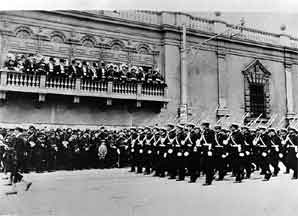Peruvian President Ousted

Peru
A rebellion broke out in Southern Peru in August. As a result, Peruvian President Ausgusto Leguioa was forced to resign.
Background
Augusto B. Leguía, who was President of Peru from 1908 to 1912 and then again from 1919 to 1930, is often remembered for his "Oncenio," referring to his second presidency which lasted for eleven years. Initially, his rule brought about significant modernization and economic development, largely driven by foreign investments and an emphasis on infrastructure projects.
However, his government gradually became more dictatorial. Leguía dissolved opposition parties, censored the press, and manipulated elections to maintain his grip on power. Over time, his regime became unpopular due to perceived corruption, economic mismanagement, and the disenfranchisement of political opponents.
Economic Context
The global context also played a significant role. The onset of the Great Depression in 1929 severely impacted the Peruvian economy, which was heavily dependent on the export of raw materials such as sugar and cotton. Prices and demand for these goods plummeted, leading to economic hardship and increased public discontent against Leguía's government.
The Rebellion
In August 1930, the discontent culminated in a military-led rebellion that started in the southern city of Arequipa, which was a traditional stronghold of opposition against the central government in Lima. The rebellion quickly gained support among various sectors of society, including other military factions, political groups opposed to Leguía, and the general public.
Leguía’s Resignation
As the rebellion spread and its support widened, it became clear that Leguía could no longer maintain control. Faced with mounting opposition and diminishing options, Leguía was forced to resign in August 1930. His resignation marked the end of his authoritarian regime but also plunged the country into a period of political instability.
Aftermath
Following Leguía's resignation, a military junta took over the government, led by Colonel Luis M. Sánchez Cerro, who proclaimed himself President. His government initially tried to restore order and public confidence but continued to face various challenges, including ongoing political instability, economic difficulties, and social unrest. Sánchez Cerro himself would later be elected in 1931 in a contested election and then assassinated in 1933, highlighting the turbulent political climate in Peru during this period.
The fall of Leguía and the events of 1930 are seen as a turning point in Peruvian history, reflecting the volatile interplay between military power and civilian governance, and the profound impact of economic forces on political stability.
 >
>